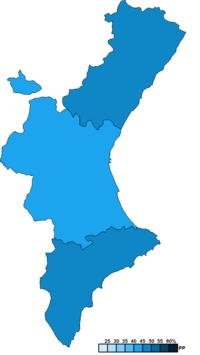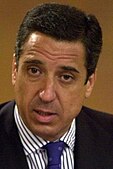1995 Valencian regional election
| ||||||||||||||||||||||||||||||||||||||||||||||||||||||||||||||||||||||||||||||||||
All 89 seats in the Corts Valencianes 45 seats needed for a majority | ||||||||||||||||||||||||||||||||||||||||||||||||||||||||||||||||||||||||||||||||||
|---|---|---|---|---|---|---|---|---|---|---|---|---|---|---|---|---|---|---|---|---|---|---|---|---|---|---|---|---|---|---|---|---|---|---|---|---|---|---|---|---|---|---|---|---|---|---|---|---|---|---|---|---|---|---|---|---|---|---|---|---|---|---|---|---|---|---|---|---|---|---|---|---|---|---|---|---|---|---|---|---|---|---|
| Opinion polls | ||||||||||||||||||||||||||||||||||||||||||||||||||||||||||||||||||||||||||||||||||
| Registered | 3,131,191 | |||||||||||||||||||||||||||||||||||||||||||||||||||||||||||||||||||||||||||||||||
| Turnout | 2,380,614 (76.0%) | |||||||||||||||||||||||||||||||||||||||||||||||||||||||||||||||||||||||||||||||||
| ||||||||||||||||||||||||||||||||||||||||||||||||||||||||||||||||||||||||||||||||||
 Constituency results map for the Corts Valencianes | ||||||||||||||||||||||||||||||||||||||||||||||||||||||||||||||||||||||||||||||||||
| ||||||||||||||||||||||||||||||||||||||||||||||||||||||||||||||||||||||||||||||||||
The 1995 Valencian regional election was held on Sunday, 28 May 1995, to elect the 4th Corts of the Valencian Community. All 89 seats in the Corts were up for election. The election was held simultaneously with regional elections in twelve other autonomous communities and local elections all throughout Spain.
As a result of the election, the People's Party (PP) increased its vote share by 15 percentage points relative to the 1991 Courts elections. For the first time, the PP had won a regional election, becoming the first party to poll more than 1 million votes in the area and gaining eleven seats, 3 short of an absolute majority. Most of the gains came from Spanish Socialist Workers' Party (PSOE), which lost 13 seats in the election. The regionalist Valencian Union (UV) also lost 1 seat, while United Left (IU) gained 4 seats to overtake UV as the third largest party.
A coalition agreement between the PP and UV was able to force the PSOE out from the Valencian Government after 12 years of Socialist rule. Eduardo Zaplana, the People's Party's candidate, became the second democratically elected President of the autonomous community
Overview
Electoral system
The
Voting for the Corts was on the basis of
The electoral law provided that parties, federations, coalitions and
Election date
The term of the Corts Valencianes expired four years after the date of their previous election, with elections to the Corts being fixed for the fourth Sunday of May every four years. The previous election was held on 26 May 1991, setting the election date for the Corts on Sunday, 28 May 1995.[1][2][3]
The Corts Valencianes could not be dissolved before the date of expiry of parliament.[1]
Background
After 12 years of consecutive Socialist governments both in the Spanish national government and in the Valencian Community, the People's Party (PP) had managed to greatly increase its support from 1992–93, mostly at the cost of what remained of the Democratic and Social Centre (CDS). In the 1993 general election, the PP had already increased its vote share from 27.0% in 1989 to 40.5% and had overtaken the Spanish Socialist Workers' Party (PSOE) in the region for the first time. The party had also seen a dramatical rise in the 1994 European Parliament election, rising to 44.2% from 22.8% in 1989.
United Left (IU) had gained ground at the expense of the PSOE and in both the 1993 general and 1994 EP elections had polled more than 10% for the first time since the 1970s. After peaking in the 1991 Courts and local elections, the right-wing regional party Valencian Union (UV) had begun to lose ground in the 1993 and 1994 elections.
Population's weariness of PSOE's prolonged stay in power, economic crisis as well as the eruption of numerous corruption scandals at the national level had weakened the PSOE in the region to the point it was facing the possibility of a severe defeat for the first time in a decade. Joan Lerma's management of a wildfire crisis in the summer of 1994 came under heavy criticism, after the fire had resulted in the burning of 16% of the region's forest area.[4]
Opinion polls
The table below lists voting intention estimates in reverse chronological order, showing the most recent first and using the dates when the survey fieldwork was done, as opposed to the date of publication. Where the fieldwork dates are unknown, the date of publication is given instead. The highest percentage figure in each polling survey is displayed with its background shaded in the leading party's colour. If a tie ensues, this is applied to the figures with the highest percentages. The "Lead" column on the right shows the percentage-point difference between the parties with the highest percentages in a poll. When available, seat projections determined by the polling organisations are displayed below (or in place of) the percentages in a smaller font; 45 seats were required for an
- Color key:
Exit poll
| Polling firm/Commissioner | Fieldwork date | Sample size | Turnout | Lead | |||||
|---|---|---|---|---|---|---|---|---|---|
| 1995 regional election | 28 May 1995 | — | 76.0 | 34.0 32 |
42.8 42 |
7.0 5 |
11.5 10 |
8.8 | |
| Eco Consulting/RTVE[p 1] | 28 May 1995 | ? | ? | 31.3 30/31 |
43.5 42/45 |
6.5 3/5 |
15.0 9/12 |
12.2 | |
| Emer–GfK/Levante-EMV[p 2] | 21 May 1995 | ? | ? | ? 32/34 |
? 42/45 |
? 0/4 |
? 10/11 |
? | |
| Gesfono/Las Provincias[p 2][p 3] | 10–15 May 1995 | ? | ? | 30.1 28/31 |
46.0 43/46 |
6.0 3/4 |
13.2 11/12 |
15.9 | |
| Demoscopia/El País[p 4][p 5][p 6][p 7] | 10–15 May 1995 | 1,200 | ? | 29.1 29 |
44.0 43 |
6.6 6 |
13.3 11 |
14.9 | |
| CIS[p 8][p 9] | 24 Apr–10 May 1995 | 1,598 | 72.3 | 30.7 | 46.5 | 6.7 | 10.9 | 15.8 | |
| Perfiles[p 2] | 7 May 1995 | ? | ? | ? 32/34 |
? 42/45 |
? 0/4 |
? 10/11 |
? | |
| Gesfono/Las Provincias[p 2] | 30 Apr 1995 | ? | ? | 30.1 29/30 |
45.2 43/44 |
6.2 4 |
13.5 12 |
15.1 | |
| 1994 EP election | 12 Jun 1994 | — | 65.0 | 30.5 (29) |
44.2 (45) |
5.3 (3) |
13.9 (12) |
13.7 | |
| 1993 general election | 6 Jun 1993 | — | 81.7 | 38.4 (39) |
40.5 (41) |
4.6 (0) |
10.5 (9) |
2.1 | |
| 1991 regional election | 26 May 1991 | — | 69.2 | 42.8 45 |
27.8 31 |
10.4 7 |
7.5 6 |
15.0 | |
Results
Overall
 | ||||||
| Parties and alliances | Popular vote | Seats | ||||
|---|---|---|---|---|---|---|
| Votes | % | ±pp | Total | +/− | ||
| People's Party (PP) | 1,013,859 | 42.83 | +15.01 | 42 | +11 | |
| Spanish Socialist Workers' Party (PSOE) | 804,463 | 33.98 | –8.87 | 32 | –13 | |
| United Left–The Greens (EU–EV)1 | 273,030 | 11.53 | +2.24 | 10 | +4 | |
| Valencian Union–Independents–Centrists (UV–FICVA–CCV) | 165,956 | 7.01 | –3.35 | 5 | –2 | |
| Valencian People's Union–Nationalist Bloc (UPV–BN) | 64,253 | 2.71 | –0.97 | 0 | ±0 | |
| Democratic and Social Centre (CDS) | 5,480 | 0.23 | –3.58 | 0 | ±0 | |
| Communist Party of the Peoples of Spain (PCPE) | 3,772 | 0.16 | +0.02 | 0 | ±0 | |
| United Alicante (AU) | 2,894 | 0.12 | New | 0 | ±0 | |
| Autonomist Republican Party (PRA) | 2,232 | 0.09 | New | 0 | ±0 | |
| Valencian Nationalist Left (ENV)2 | 1,861 | 0.08 | –0.03 | 0 | ±0 | |
| Spanish Phalanx of the CNSO (FE–JONS) | 1,762 | 0.07 | New | 0 | ±0 | |
| Platform of Independents of Spain (PIE) | 1,659 | 0.07 | New | 0 | ±0 | |
| Humanist Platform (PH–LE) | 773 | 0.03 | New | 0 | ±0 | |
| Spanish Autonomous League (LAE) | 542 | 0.02 | New | 0 | ±0 | |
| Blank ballots | 24,864 | 1.05 | +0.02 | |||
| Total | 2,367,400 | 89 | ±0 | |||
| Valid votes | 2,367,400 | 99.44 | ±0.00 | |||
| Invalid votes | 13,214 | 0.56 | ±0.00 | |||
| Votes cast / turnout | 2,380,614 | 76.03 | +6.79 | |||
| Abstentions | 750,577 | 23.97 | –6.79 | |||
| Registered voters | 3,131,191 | |||||
| Sources[5][6][7] | ||||||
Footnotes:
| ||||||
Distribution by constituency
| Constituency | PP | PSOE | EU–EV | UV–FI–C | ||||
|---|---|---|---|---|---|---|---|---|
| % | S | % | S | % | S | % | S | |
| Alicante | 46.7 | 15 | 36.0 | 12 | 10.9 | 3 | 2.1 | − |
| Castellón | 45.6 | 11 | 35.6 | 8 | 8.2 | 2 | 4.4 | 1 |
| Valencia | 40.1 | 16 | 32.5 | 12 | 12.6 | 5 | 10.3 | 4 |
| Total | 42.8 | 42 | 34.0 | 32 | 11.5 | 10 | 7.0 | 5 |
| Sources[6][7] | ||||||||
Aftermath
| Investiture | |||||
| Candidate | Ballot → | 30 June 1995 | |||
|---|---|---|---|---|---|
| Required majority → | 45 out of 89 | ||||
| Eduardo Zaplana (PP) | 47 / 89
|
||||
42 / 89
| |||||
| Abstentions | 0 / 89
| ||||
| Absentees | 0 / 89
| ||||
| Joan Lerma (PSOE) | |||||
| Albert Taberner (EU–EV) | |||||
| Sources[7] | |||||
Notes
References
- Opinion poll sources
- ^ "El PP se impuso en diez comunidades". Diario de Navarra (in Spanish). 29 May 1995.
- ^ a b c d "Corts. Anuario de Derecho parlamentario" (PDF). Corts Valencianes (in Spanish). 1996.
- ^ "Los sondeos predicen una amplia victoria del PP en las autonómicas". Diario de Navarra (in Spanish). 22 May 1995.
- ^ "El PP será la fuerza más votada en 12 comunidades". El País (in Spanish). 20 May 1995.
- ^ "Lerma cede el testigo". El País (in Spanish). 20 May 1995.
- ^ "Mañana, previsiones para las municipales". El País (in Spanish). 20 May 1995.
- ^ "El PP gana en doce autonomías y el PSOE sólo en Extremadura, según un sondeo". La Vanguardia (in Spanish). 21 May 1995.
- ^ "Preelectoral Autonómicas Comunidad Valenciana (Estudio nº 2167. Abril-Mayo 1995)". CIS (in Spanish). 10 May 1995.
- ^ "Estudio CIS nº 2167. Ficha técnica" (PDF). CIS (in Spanish). 10 May 1995.
- Other
- ^ a b c d Ley Orgánica 5/1982, de 1 de julio, de Estatuto de Autonomía de la Comunidad Valenciana (Organic Law 1) (in Spanish). 1 July 1982. Retrieved 17 March 2017.
- ^ a b c Ley 1/1987, de 31 de marzo, Electoral Valenciana (Law 2) (in Spanish). 31 March 1987. Retrieved 17 March 2017.
- ^ a b Ley Orgánica 5/1985, de 19 de junio, del Régimen Electoral General (Organic Law 5) (in Spanish). 19 June 1985. Retrieved 28 December 2016.
- ^ "The summer in which the Community burned" (in Spanish). Las Provincias. 2009-08-10.
- ^ "Electoral Results. Electoral Data - Regional Election: 1995". www.cortsvalencianes.es (in Spanish). Valencian Government. Retrieved 29 November 2019.
- ^ a b "Corts Valencianes election results, 28 May 1995" (PDF). www.juntaelectoralcentral.es (in Spanish). Electoral Commission of the Valencian Community. 22 June 1995. Retrieved 30 September 2017.
- ^ a b c "Eleccions a les Corts Valencianes (1983 - 2019)". Historia Electoral.com (in Spanish). Retrieved 30 September 2017.



